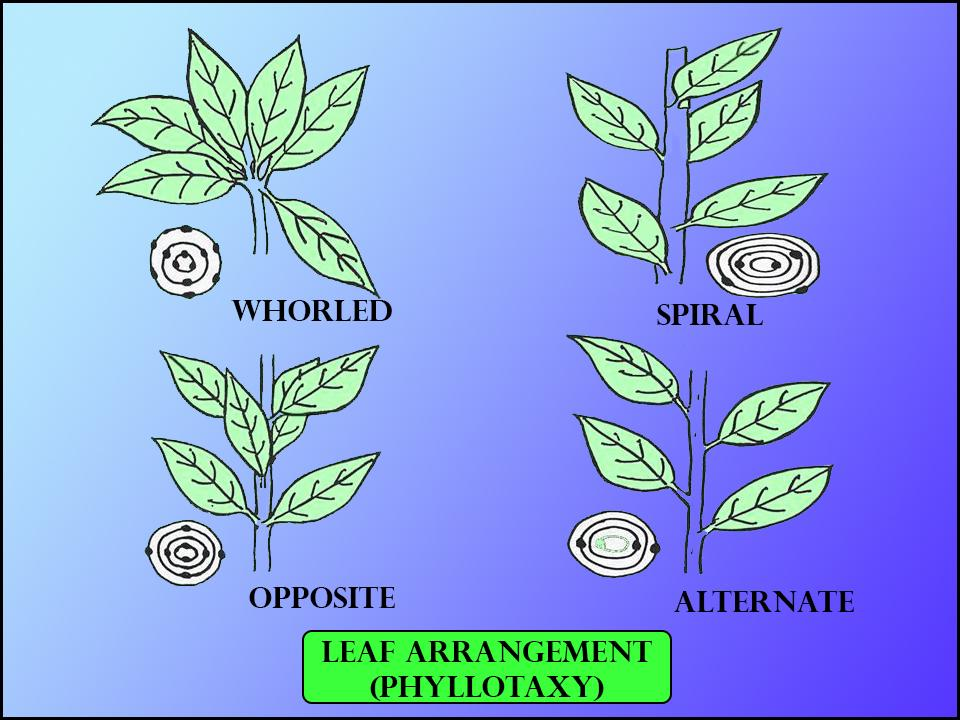
The angle of divergence in tristichous phyllotaxy is
(a)140 degree
(b)135 degree
(c)180 degree
(d)120 degree
Answer
469.5k+ views
Hint: The arrangement of leaves in a different rotational angle of the stem which is found to be in various patterns naturally and shows the variation in different plants.
Complete answer:
Phyllotaxy is the mode of the arrangement of the leaves on the stem. Tristichous phyllotaxy is also called as one by three phyllotaxy. In this, the first, fourth, seventh leaf bases fall on the same plane; the second, fifth, eighth leaf bases on the same plane and third, sixth and ninth on the same plane one above the other. In this, the angle of divergence is 120 degrees.
Additional Information:
-The term phyllotaxy was coined by Charles Bonnet to describe the arrangement of leaves on a plant.
-There are three basic types of phyllotaxy in plants, they are:
Opposite phyllotaxy – it is the basic arrangement of leaves on the stem. From the opposite sides of the stem from its base, two leaves arise.
Spiral phyllotaxy – in this arrangement only a single leaf arises at each node and borne along the stem alternately in an ascending spiral. Tristichous phyllotaxy is the arrangement of leaves that spiral, in three alternate vertical rows. In this mode of arrangement, the first, fourth, seventh, and tenth leaf remains in one row while the third, sixth, ninth, and twelfth in the second row and second, fifth, eighth, and eleventh in the third row. This angular divergence is 120. For example, Cyperus.
Whorled phyllotaxy – in this arrangement, several leaves may arise from the same node on a stem.
-With an alternate or spiral arrangement, each leaf arises at a different node on the stem.
-The rotational angle from the leaf in a repeating spiral can be represented by a fraction of a full rotation around the stem.
So, the correct answer is, ‘120 degrees.’
Note: Leonardo da Vinci made observations of the spiral arrangements of plants first. In 1754, Charles Bonnet observed that the spiral phyllotaxy of plants was frequently expressed in both clockwise and anticlockwise golden ratio series. The mathematical observations of phyllotaxy were done by Karl Friedrich Schimper and his friend Alexander Braun’s in 1830.

Complete answer:
Phyllotaxy is the mode of the arrangement of the leaves on the stem. Tristichous phyllotaxy is also called as one by three phyllotaxy. In this, the first, fourth, seventh leaf bases fall on the same plane; the second, fifth, eighth leaf bases on the same plane and third, sixth and ninth on the same plane one above the other. In this, the angle of divergence is 120 degrees.
Additional Information:
-The term phyllotaxy was coined by Charles Bonnet to describe the arrangement of leaves on a plant.
-There are three basic types of phyllotaxy in plants, they are:
Opposite phyllotaxy – it is the basic arrangement of leaves on the stem. From the opposite sides of the stem from its base, two leaves arise.
Spiral phyllotaxy – in this arrangement only a single leaf arises at each node and borne along the stem alternately in an ascending spiral. Tristichous phyllotaxy is the arrangement of leaves that spiral, in three alternate vertical rows. In this mode of arrangement, the first, fourth, seventh, and tenth leaf remains in one row while the third, sixth, ninth, and twelfth in the second row and second, fifth, eighth, and eleventh in the third row. This angular divergence is 120. For example, Cyperus.
Whorled phyllotaxy – in this arrangement, several leaves may arise from the same node on a stem.
-With an alternate or spiral arrangement, each leaf arises at a different node on the stem.
-The rotational angle from the leaf in a repeating spiral can be represented by a fraction of a full rotation around the stem.
So, the correct answer is, ‘120 degrees.’
Note: Leonardo da Vinci made observations of the spiral arrangements of plants first. In 1754, Charles Bonnet observed that the spiral phyllotaxy of plants was frequently expressed in both clockwise and anticlockwise golden ratio series. The mathematical observations of phyllotaxy were done by Karl Friedrich Schimper and his friend Alexander Braun’s in 1830.

Recently Updated Pages
Questions & Answers - Ask your doubts

Master Class 11 Accountancy: Engaging Questions & Answers for Success

Master Class 11 Science: Engaging Questions & Answers for Success

Full Form of IASDMIPSIFSIRSPOLICE class 7 social science CBSE

In case of conflict between fundamental rights of citizens class 7 social science CBSE

Can anyone list 10 advantages and disadvantages of friction

Trending doubts
10 examples of friction in our daily life

The correct order of melting point of 14th group elements class 11 chemistry CBSE

Difference Between Prokaryotic Cells and Eukaryotic Cells

One Metric ton is equal to kg A 10000 B 1000 C 100 class 11 physics CBSE

What is the specific heat capacity of ice water and class 11 physics CBSE

State and prove Bernoullis theorem class 11 physics CBSE




